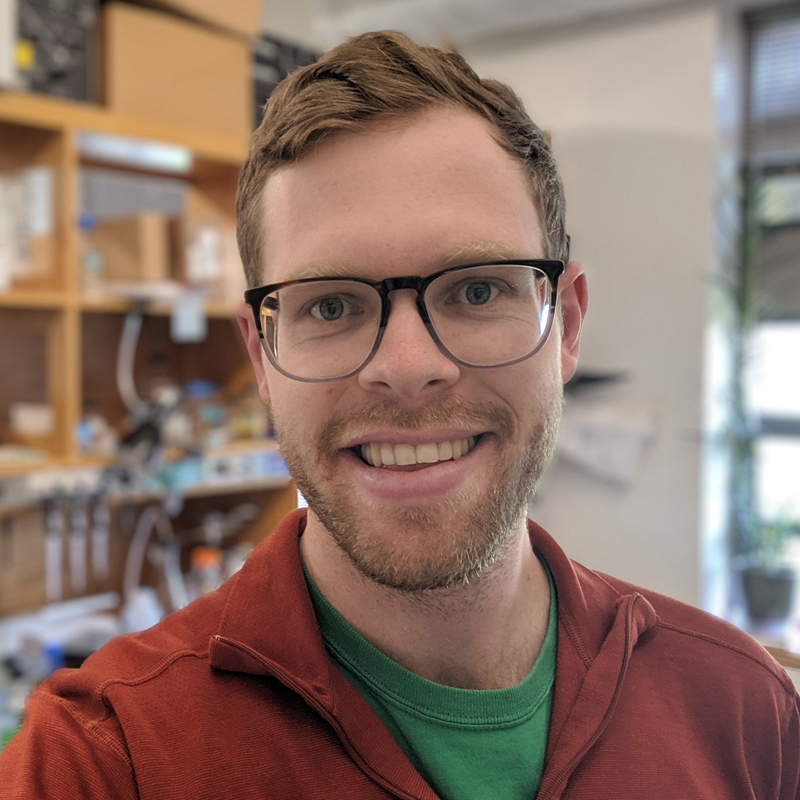Drew Bridges
Assistant Professor
Address:
238 Mellon Institute
Department of Biological Sciences
Carnegie Mellon University
4400 Fifth Avenue
Pittsburgh, PA 15213

Education
Postdoctoral Appointment, Princeton University
Research
In the Bridges lab, we study how bacteria make developmental decisions based on extracellular sensory information. The developmental program on which we focus is the formation and disassembly of multicellular bacterial communities called biofilms. Previously, we pioneered the use of new imaging approaches to investigate the full biofilm lifecycle in the global pathogen, Vibrio cholerae, from initial cell attachment to biofilm growth, to biofilm disassembly. Because little was known about how biofilm disassembly occurs, to date, we have concentrated primarily on this phase of the process. We combine imaging approaches with techniques including genetics, biochemistry, and biophysics theory to discover and characterize the molecular mechanisms controlling biofilm dispersal.
The Bridges lab recently launched in the historic Mellon Institute building at Carnegie Mellon University as of September 2022. Our group will investigate how bacteria control lifestyle changes across scales: from the signaling molecules, to the signal transduction circuits, to the individual cell, to the community. In the long term, our research program will expand to other microorganisms and their unique lifestyles to learn what principles are general and which are species-specific. Our discoveries will be relevant to infection and could inform the development of approaches to manipulate bacterial behavior, potentially leading to new strategies for controlling disease. We strive to create an engaging, diverse, inclusive, and immersive intellectual atmosphere for trainees. Join us on the adventure!
Publications
Bridges, A. A., Prentice, J.A., Wingreen, N.S., Bassler, B. L. (2022) Signal Transduction Network Principles Underlying Bacterial Collective Behaviors. Annual Review of Microbiology. Invited submission. 76.
Bridges, A. A.*, Prentice, J.A.*, Fei, C., Wingreen, N.S., Bassler, B. L. (2022) Quantitative input-output dynamics of a c-di-GMP signal-transduction cascade in Vibrio cholerae. PLoS Biology 20 (3).*These authors contributed equally.
Bridges, A. A. and Bassler, B. L. (2021) Inverse regulation of Vibrio cholerae biofilm dispersal by polyamine signals. eLife 10, e65487.
Bridges, A. A., Fei, C., Bassler, B. L. (2020) Identification of signaling pathways, matrix-digestion enzymes, and motility components controlling Vibrio cholerae biofilm dispersal. Proceedings of the National Academy of Sciences of the United States of America 117 (51), 32639-32647.
Qin, B., Fei, C., Bridges, A. A., Mashruwala, A., Stone, H., Wingreen, N. S., Bassler, B. L. (2020) Cell fates and collective fountain flow in bacterial biofilms revealed by light-sheet microscopy. Science 369, 71-77.
Silpe, J. E.*, Bridges, A. A*., Huang X., Coronado D. R., Duddy O. P., Bassler B. L. (2020) Separating functions of the phage-encoded quorum-sensing-activated antirepressor Qtip. Cell Host & Microbe 27, 629–641. *These authors contributed equally.
Bridges, A. A. and Bassler, B. L. (2019) The intra-genus and inter-species quorum-sensing autoinducers exert distinct control over Vibrio cholerae biofilm formation and dispersal. PLoS Biology 17, 11.
Bridges, A. A., and Gladfelter, A. S. (2016) Septin complexes assemble during a kinetic window of opportunity. Cell cycle 11, 1-2.
Bridges, A. A., and Gladfelter, A. S. (2016) In vitro reconstitution of septin assemblies on supported lipid bilayers. Methods in Cell Biology 136, 57-71.
Bridges, A. A., Jentzsch, M. S., Occhipinti, P. Oakes, P.W., Gladfelter, A. S. (2016) Micron-scale plasma membrane curvature is recognized by the septin cytoskeleton. Journal of Cell Biology 213, 23-32.
Zhang, H., Elbaum-Garfinkle, S., Langdon, E.M., Taylor, N., Occhipinti, P., Bridges, A. A., Brangwynne, C. P., Gladfelter, A. S. (2015) RNA controls polyQ protein phase transitions. Molecular Cell 60, 220-230.
Bridges, A. A., and Gladfelter, A. S. (2015) Septin form and function at the cell cortex. The Journal of Biological Chemistry 290, 17173-17180.
Kaplan, C., Jing, B., Winterflood, C. M., Bridges, A. A., Occhipinti, P., Schmied, J., Grinhagens, S., Gronemeyer, T., Tinnefeld, P., Gladfelter, A. S., Ries, J., and Ewers, H. (2015) Absolute arrangement of subunits in cytoskeletal septin filaments in cells Measured by fluorescence microscopy. Nano Letters 15, 3859-3864.
Bridges, A. A., and Gladfelter, A. S. (2014) Fungal pathogens are platforms for discovering novel and conserved septin properties. Current Opinion in Microbiology 20, 42-48.
Bahl, C. D., Hvorecny, K. L., Bridges, A. A., Ballok, A. E., Bomberger, J. M., Cady, K. C., O’Toole, G. A., and Madden, D. R. (2014) Signature motifs identify an Acinetobacter Cif virulence factor with epoxide hydrolase activity. The Journal of Biological Chemistry 289, 7460-7469.
Bridges, A. A., Zhang, H., Mehta, S. B., Occhipinti, P., Tani, T., and Gladfelter, A. S. (2014) Septin assemblies form by diffusion-driven annealing on membranes. Proceedings of the National Academy of Sciences of the United States of America 111, 2146-2151.
Sellin Jeffries, M. K., Conoan, N. H., Cox, M. B., Sangster, J. L., Balsiger, H. A., Bridges, A. A., Cowman, T., Knight, L. A., Bartelt-Hunt, S. L., and Kolok, A. S. (2011) The anti-estrogenic activity of sediments from agriculturally intense watersheds: assessment using in vivo and in vitro assays. Aquatic Toxicology 105, 189-198.